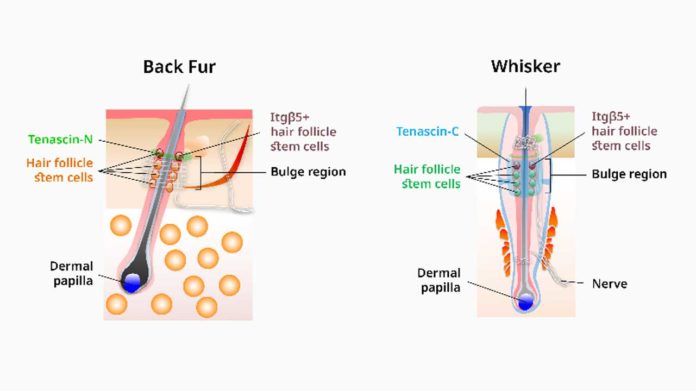Despite the prevalence of hair loss, baldness affects approximately 50% of men, and 50% of women suffer from baldness. A drug capable of stopping it in its tracks has so far proven elusive.
To prevent hair loss, it is essential to understand the molecular mechanisms that underpin human hair growth and loss.
Hair growth in mammals is a continuous cyclical process in which hair grows, falls out, and is grown again. Growth occurs in the anagen phase, and hair falls out in the telogen phase. Thus, successful hair-regeneration treatment must produce hair that recycles.
Recently, scientists at the RIKEN Center for Biosystems Dynamics Research in Japan have discovered a recipe for continuous cyclical regeneration of cultured hair follicles from hair follicle stem cells.

Scientists took fur and whisker cells from mice and cultured them in the laboratory with other biological “ingredients.” They used 220 combinations of ingredients and found that combining a type of collagen with five factors — the NFFSE medium — led to the highest stem cell amplification rate in the shortest period.
To test whether stem cells cultured in the NFFSE medium produce hair that cycles, the analysts placed bioengineered hair follicle stem cells in NFFSE medium or medium missing one of the ingredients and noticed the recovered hair for several weeks. They discovered 81% of hair follicles generated in the NFFSE medium went through at least three hair cycles and produced normal hair. Conversely, 79% of follicles filled in the other medium produced only one hair cycle.
First author Makoto Takeo said, “Knowing that stem-cell renewal can depend on what is attached to the outside of the cells, the researchers next looked for markers on the surface of cells cultured in the NFFSE medium. In addition to the expected CD34 and CD49f markers, they found the best hair cycling was related to the addition of Itgβ5. We found almost 80% of follicles reached three hair cycles when Itgβ5 was also bioengineered into the hair follicle germ. In contrast, only 13% reached three cycles when it was not present. The analysis showed that these important cells are naturally located in the upper part of the hair follicle’s bulge region.”
Takashi Tsuji, who led the team, said, “Our culture system establishes a method for cyclical regeneration of hair follicles from hair follicle stem cells and will help make a better cure for baldness in the near future.”
“RIKEN is primarily an institute that does basic research. And clinical trials usually require outside collaborators. We are therefore looking for a partner company to help develop the clinical applications and welcome donations to promote the R&D.”
Journal Reference:
- Takeo et al. (2021) Expansion and characterization of epithelial stem cells with cyclical hair regeneration potential. Sci Rep. DOI: 10.1038/s41598-020-80624-3
